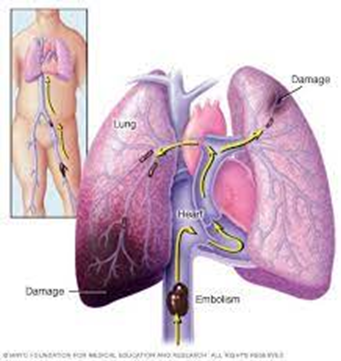A nurse is assessing a client who has a spinal cord injury with heterotopic ossifications. Which of the following findings should the nurse expect?
Hypertension
Bradycardia
Fecal impaction
Arthralgia
The Correct Answer is D
Choice A Reason:
Hypertension is not typically associated with heterotopic ossifications. However, it may occur in individuals with spinal cord injuries (SCI) due to autonomic dysreflexia, a condition characterized by an exaggerated sympathetic response to stimuli below the level of injury. Autonomic dysreflexia can lead to a sudden increase in blood pressure, which, if left untreated, can result in complications such as stroke or seizure. However, hypertension is not directly related to heterotopic ossifications.
Choice B Reason:
Bradycardia is also not typically associated with heterotopic ossifications. Like hypertension, bradycardia may occur in individuals with SCI due to autonomic dysreflexia. Autonomic dysreflexia can lead to a sudden increase in blood pressure and a reflex bradycardia in response to the increased sympathetic outflow. However, bradycardia is not directly related to heterotopic ossifications.
Choice C Reason:
Fecal impaction is a potential complication of spinal cord injury (SCI) due to impaired bowel function, but it is not directly related to heterotopic ossifications. SCI can disrupt normal bowel motility and result in neurogenic bowel dysfunction, leading to symptoms such as constipation, fecal impaction, and bowel obstruction. However, fecal impaction is not specific to heterotopic ossifications.
Choice D Reason:
Arthralgia is correct. Heterotopic ossifications (HO) involve the abnormal formation of bone in soft tissues around joints, muscles, tendons, or ligaments. When HO occurs around joints, it can lead to symptoms such as pain, swelling, and decreased range of motion, collectively known as arthralgia. Therefore, arthralgia is a common finding associated with heterotopic ossifications in individuals with spinal cord injuries.
Nursing Test Bank
Naxlex Comprehensive Predictor Exams
Related Questions
Correct Answer is D
Explanation
Choice A Reason:
Myelogram is not appropriate. This imaging test involves injecting contrast dye into the spinal canal to visualize the spinal cord and nerve roots. While it may help identify certain spinal cord abnormalities, it is not typically used as a primary diagnostic tool for multiple sclerosis.
Choice B Reason:
Brain natriuretic peptide (BNP) is not appropriate. This blood test measures the level of BNP, a hormone produced by the heart, which can be elevated in conditions such as heart failure. It is not used in the diagnosis of multiple sclerosis.
Choice C Reason:
Troponin level is not appropriate. Troponin is a protein released into the bloodstream during a heart attack or other heart-related conditions. This test is used to diagnose heart muscle damage and is not relevant to the diagnosis of multiple sclerosis.
Choice D Reason:
Lumbar puncture is appropriate. Also known as a spinal tap, a lumbar puncture involves collecting cerebrospinal fluid (CSF) from the spinal canal for analysis. In the diagnosis of multiple sclerosis, analysis of CSF can help identify certain abnormalities, such as an elevated level of immunoglobulin G (IgG) or the presence of oligoclonal bands, which are often indicative of inflammation in the central nervous system. Therefore, a lumbar puncture is commonly ordered to assist with the diagnosis of multiple sclerosis.
Correct Answer is D
Explanation
Correct answer: D
Choice A Reason:
Decreased pulmonary vascular resistance is incorrect. Inflammatory mediators released in response to a pulmonary embolism can lead to vasoconstriction and increased pulmonary vascular resistance. This is part of the body's response to redirect blood flow away from the affected area of the lung and maintain adequate perfusion to other areas.
Choice B Reason:
Hypercapnia is incorrect. Hypercapnia refers to elevated levels of carbon dioxide (CO2) in the blood.Hypocapnia usually is present with embolism; hypercapnia, on the other hand, is rare.
Choice C Reason:
Hypoventilation is incorrect. Hypoventilation occurs when there is inadequate ventilation of the lungs relative to metabolic demands. In the context of a pulmonary embolism, hypoventilation can occur due to factors such as pain, respiratory muscle fatigue, or impaired gas exchange, all of which can be influenced by the release of inflammatory mediators.
Choice D Reason:
Respiratory alkalosis is correct.In response to the blockage and the resulting inflammation, the body often increases the respiratory rate as a compensatory mechanism to maintain adequate oxygen levels and remove carbon dioxide.Due to the increased breathing rate, there is excessive exhalation of carbon dioxide, leading to a decrease in the partial pressure of CO2 in the blood. This results in an increase in blood pH, causing respiratory alkalosis.

Whether you are a student looking to ace your exams or a practicing nurse seeking to enhance your expertise , our nursing education contents will empower you with the confidence and competence to make a difference in the lives of patients and become a respected leader in the healthcare field.
Visit Naxlex, invest in your future and unlock endless possibilities with our unparalleled nursing education contents today
Report Wrong Answer on the Current Question
Do you disagree with the answer? If yes, what is your expected answer? Explain.
Kindly be descriptive with the issue you are facing.
